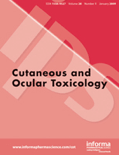
Cutaneous and Ocular Toxicology
Scope & Guideline
Innovating insights into cutaneous and ocular health.
Introduction
Aims and Scopes
- Toxicological Evaluation:
The journal emphasizes the assessment of the toxicity of drugs, chemicals, and environmental factors on skin and ocular tissues, utilizing both in vitro and in vivo models. - Clinical and Preclinical Research:
It publishes studies that bridge clinical insights with preclinical findings, ensuring that research is relevant to real-world applications in dermatology and ophthalmology. - Innovative Treatment Approaches:
The journal covers novel therapeutic strategies for managing skin and ocular diseases, including the use of traditional and herbal remedies, as well as advancements in pharmacotherapy. - Environmental Impacts on Skin and Eyes:
Research exploring the effects of environmental factors, such as pollutants and UV exposure, on skin and ocular health is a core focus, highlighting the growing concern of environmental toxicology. - Interdisciplinary Collaborations:
The journal encourages interdisciplinary research that combines dermatology, toxicology, pharmacology, and environmental science to provide comprehensive insights into skin and ocular health.
Trending and Emerging
- Impact of Environmental Toxins:
There is an increasing focus on the effects of environmental toxins, including heavy metals and pollutants, on skin and ocular health, reflecting a broader societal concern about environmental safety. - Systemic Effects of Dermatological Treatments:
Research investigating the systemic implications of dermatological treatments, particularly in relation to ocular health, is gaining prominence, emphasizing the interconnectedness of bodily systems. - Innovative Biomaterials and Treatments:
New studies are exploring the safety and efficacy of innovative biomaterials in ocular and cutaneous applications, including drug delivery systems and regenerative medicine approaches. - Role of Immune Response in Toxicity:
Emerging research is increasingly examining how immune responses contribute to skin and ocular toxicity, particularly in the context of treatments like immune checkpoint inhibitors. - Herbal and Natural Remedies:
There is a rising interest in the use of herbal and natural remedies for treating skin and ocular conditions, with studies focusing on their efficacy, safety, and mechanistic insights.
Declining or Waning
- Traditional Chemical Toxicity:
Research focused solely on the traditional chemical toxicity of known substances is becoming less frequent, possibly due to a shift towards more complex and multi-faceted studies involving environmental and biological interactions. - Static Ophthalmic Treatments:
Papers centered on static or conventional ophthalmic treatments without a toxicological angle are declining, as the field increasingly emphasizes the need for studies that incorporate safety evaluations and innovative therapies. - Aging and Skin Toxicity Studies:
While aging remains a significant area of research, studies specifically dedicated to skin toxicity mechanisms in aging populations are becoming less common as broader, integrative approaches gain traction. - Single-Agent Drug Studies:
Research focusing exclusively on the effects of single-agent drugs on ocular or cutaneous toxicity is waning, with a trend towards combination therapies and multifactorial analyses.
Similar Journals

Current Research in Toxicology
Connecting Theory and Practice in ToxicologyCurrent Research in Toxicology is a pioneering journal published by ELSEVIER that serves as a vital platform for disseminating cutting-edge research in the field of toxicology, spanning from biological impacts to pharmacological applications. With an ISSN of 2666-027X and an impressive Q2 ranking in key categories such as Applied Microbiology and Biotechnology, Health, Toxicology and Mutagenesis, and Toxicology, this journal underscores its commitment to high-quality research and significant contributions to the scientific community. Based in the Netherlands, Current Research in Toxicology aims to bridge the gap between academia and industry by providing rigorously peer-reviewed articles that cover a wide array of topics including novel methodologies, regulatory challenges, and emerging trends within the domain. The journal is accessible through various platforms, making it essential for researchers, professionals, and students eager to stay updated on the latest findings and advancements in toxicology. With a comprehensive focus on integrating theory with practical application, this journal is poised to influence future studies and policies in health and environmental science.
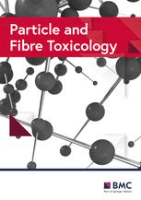
Particle and Fibre Toxicology
Illuminating the effects of environmental agents.Particle and Fibre Toxicology is a leading open-access journal dedicated to advancing the field of toxicology, specifically focusing on the health impacts of particulate matter and fibers. Published by BMC since 2004, this journal operates from its offices in the United Kingdom and has gained significant recognition in the scientific community, achieving an impressive impact factor that highlights its relevance and influence. As indicated by its Q1 ranking in various categories including Health, Toxicology and Mutagenesis and Medicine (miscellaneous), it occupies a prestigious position in the academic landscape, appealing to researchers, professionals, and students alike. With a Scopus ranking of #4 in Toxicology and #7 in Environmental Science, the journal ensures high visibility and accessibility, providing a platform for the dissemination of key research findings and innovative methodologies in the interdisciplinary domains of toxicology. Through its commitment to open access, Particle and Fibre Toxicology fosters knowledge-sharing and collaboration, facilitating significant advancements in our understanding of the toxicological effects of environmental agents.
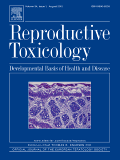
REPRODUCTIVE TOXICOLOGY
Advancing knowledge on reproductive health and toxicology.REPRODUCTIVE TOXICOLOGY, published by Pergamon-Elsevier Science Ltd, stands as a pivotal journal in the field of toxicology, specifically focusing on the effects of environmental and pharmaceutical agents on reproductive health. Established in 1987, the journal has a rich history of contributing to the scientific community, and it continues to publish rigorous research and reviews that illuminate the intricate relationships between various toxicants and their reproductive impacts. With an impressive 2023 Q2 ranking in Toxicology and a Scopus ranking of #42 out of 133 in the Toxicology category, REPRODUCTIVE TOXICOLOGY emphasizes high-quality scholarly work that influences both academia and industry practices. Researchers, professionals, and students in toxicology, pharmacology, and public health will find this journal an invaluable resource for staying informed on the latest findings and methodologies in reproductive toxicology. While the journal currently adheres to traditional publishing models without open access options, its authoritative content remains accessible to a global audience interested in advancing the understanding of toxicological impacts on reproduction.

TOXICOLOGY
Advancing toxicological insights for a safer tomorrow.TOXICOLOGY, published by Elsevier Ireland Ltd, is a prestigious peer-reviewed journal specializing in the field of toxicology. With an ISSN of 0300-483X and an E-ISSN of 1879-3185, this journal provides a vital platform for researchers, professionals, and students to disseminate and access groundbreaking studies from 1973 to present, with a convergence set until 2024. Recognized for its high impact, it holds a Q1 ranking in Toxicology category and ranks #18 out of 133 in Scopus's sector of Pharmacology, Toxicology, and Pharmaceutics, placing it in the 86th percentile. While the journal is not open access, it nonetheless offers a rich collection of research articles that enhance the understanding of toxicological science and its applications. The journal's objectives encompass advancing knowledge in the toxicological evaluation of substances, promoting safety in public health, and fostering dialogue among scholars. As a key resource in the field, TOXICOLOGY plays a crucial role in advancing research and informing practices related to toxicological risks and safety assessments.
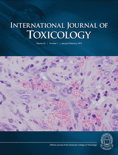
INTERNATIONAL JOURNAL OF TOXICOLOGY
Illuminating the Pathways of Toxicology Research since 1982.The International Journal of Toxicology, published by SAGE Publications Inc, serves as a cornerstone of scholarly research in the field of toxicology, with an established history dating back to 1982. This esteemed journal, ISSN 1091-5818 and E-ISSN 1092-874X, functions within the Q3 quartile in Toxicology, ranking 94 out of 133 in the Pharmacology, Toxicology and Pharmaceutics category per Scopus metrics, reflecting its commitment to advancing scientific understanding in this critical area. The journal not only aims to disseminate high-quality research but also encourages open access to vital studies, thus fostering collaboration and innovation among researchers, professionals, and students alike. With a focus on various aspects of toxicology, including but not limited to environmental, clinical, and molecular toxicology, the International Journal of Toxicology is dedicated to bridging gaps in toxicity research and promoting safe practices across numerous disciplines. As it converges towards 2024, the journal continues to play a vital role in shaping the discourse surrounding the implications of exposure to toxic substances in human health and the environment.
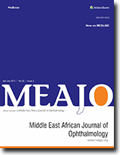
Middle East African Journal of Ophthalmology
Advancing ocular health through innovative research.The Middle East African Journal of Ophthalmology is a distinguished publication dedicated to advancing knowledge in the field of ophthalmology, published by Wolters Kluwer Medknow Publications in India. With a robust focus on contributions that bridge the gap between clinical practices and scientific research, this journal serves as a crucial platform for researchers, practitioners, and students alike. Since its inception, it has consistently disseminated high-impact research, achieving notable recognition with a Q3 ranking in both Medicine (miscellaneous) and Ophthalmology categories as of 2023. Despite being a newer entrant into the scholarly landscape, it features an array of innovative articles, highlighting significant advancements and emerging trends in ocular health. Researchers may access a wealth of knowledge through its open access articles, promoting the dissemination of vital ophthalmic research that is relevant in both Middle Eastern and African contexts. By fostering collaboration and communication among professionals in the field, the Middle East African Journal of Ophthalmology is committed to championing excellence in eye care and elevating the standard of research applicable to global populations.

Frontiers in Toxicology
Unveiling the Complexities of Pharmacological ImpactsFrontiers in Toxicology, published by Frontiers Media SA, is a prominent open-access journal dedicated to advancing the understanding of toxicological science. Established in 2019, it serves as a vital forum for innovative research, offering insights into the pharmacological impacts and toxicological profiles of various substances. With its international reach based in Switzerland, this journal has quickly ascended in the academic community, achieving a notable Q1 ranking in Pharmacology, Toxicology and Pharmaceutics (Miscellaneous) and a Q2 ranking in Toxicology as of 2023. The journal is indexed in Scopus, where it ranks #8 out of 43 in its primary category, underscoring its influence and relevance in the field. The scope encompasses cutting-edge studies on the mechanisms of toxicity, including both human and environmental impacts, making it an essential resource for researchers, professionals, and students alike. By promoting open access to high-quality research, Frontiers in Toxicology plays a crucial role in enhancing knowledge sharing and fostering collaboration across disciplines.
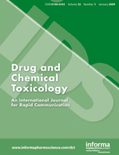
DRUG AND CHEMICAL TOXICOLOGY
Illuminating the path to chemical health and safety.Drug and Chemical Toxicology is a well-respected journal in the fields of toxicology, pharmacology, and public health, published by Taylor & Francis Ltd. Since its inception in 1978, this journal has diligently explored the effects and mechanisms of chemical exposures on health and the environment, fulfilling a crucial role in advancing scientific understanding and safeguarding public health. The journal is indexed across prestigious databases and features an impressive array of articles categorized within the Q2 and Q3 quartiles across various categories in 2023, reflecting its significance in Chemical Health and Safety as well as Environmental and Occupational Health disciplines. With an extensive reach and a focus on interdisciplinary research, Drug and Chemical Toxicology offers a rich repository of original research, reviews, and methodological advancements, catering to a diverse audience of researchers, professionals, and students dedicated to the betterment of safety and health standards. Although not an open-access publication, its articles are widely accessible to the academic community, ensuring that critical innovations and insights are shared for the greater good.

CHEMICAL RESEARCH IN TOXICOLOGY
Advancing toxicological science through chemical insights.Chemical Research in Toxicology is a premier journal published by the American Chemical Society, dedicated to advancing the understanding of toxicological effects associated with chemical substances. Since its inception in 1988, this esteemed journal has maintained a robust impact factor, ranking in the Q1 quartile for both Medicine (miscellaneous) and Toxicology as of 2023, reflecting its significance and influence in the fields of pharmacology and toxicology. With an impressive Scopus ranking at #16 out of 133 in the Toxicology category, it serves as a vital resource for researchers, professionals, and students seeking cutting-edge insights and scholarly articles that bridge the gap between chemistry and toxicological science. Although not an open-access publication, it continues to provide comprehensive analyses and original research that inform safe chemical practices and regulatory policies, further enhancing its role in public health and safety.
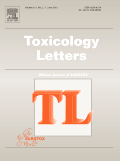
TOXICOLOGY LETTERS
Exploring the intricate dance between chemicals and biology.TOXICOLOGY LETTERS is a prominent journal dedicated to advancing the field of toxicology, providing a platform for high-quality research and reviews that explore the effects of chemical substances on biological systems. Published by Elsevier Ireland Ltd, this peer-reviewed journal has established itself as a vital resource in toxicological research since its inception in 1977, with a convergence of studies extending to 2024. With an impressive Scopus ranking, positioned at #28 out of 133 in the Toxicology category, TOXICOLOGY LETTERS garners a respectable percentile of 79, highlighting its significance in the academic community. Although it is not an open-access journal, its research is accessible through institutional subscriptions, ensuring that critical insights into human health and environmental safety are disseminated effectively. Being categorized in the Q2 quartile in both Medicine (miscellaneous) and Toxicology for 2023 further emphasizes its relevance and impact in these fields. This journal aims to foster collaboration between researchers and professionals, encouraging the exploration of innovative solutions to chemical hazards and the promotion of safer practices in pharmacology and toxicology.